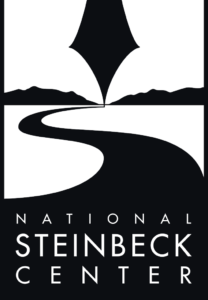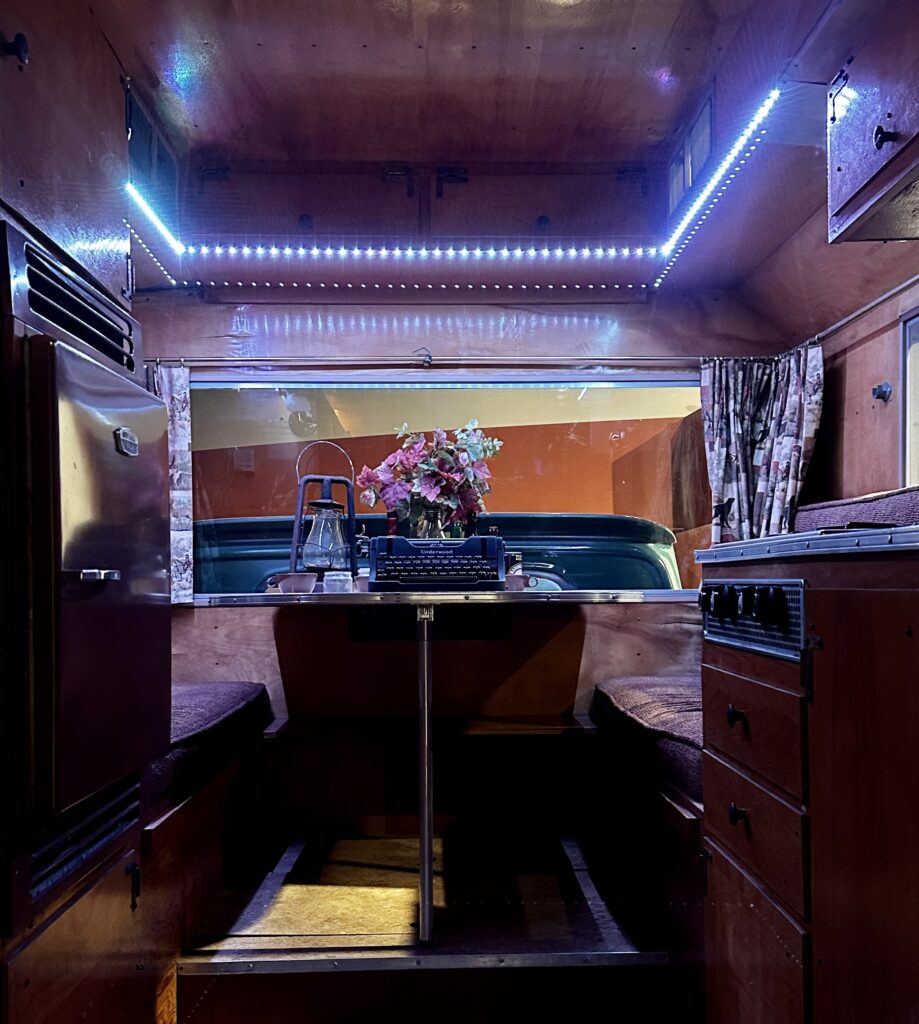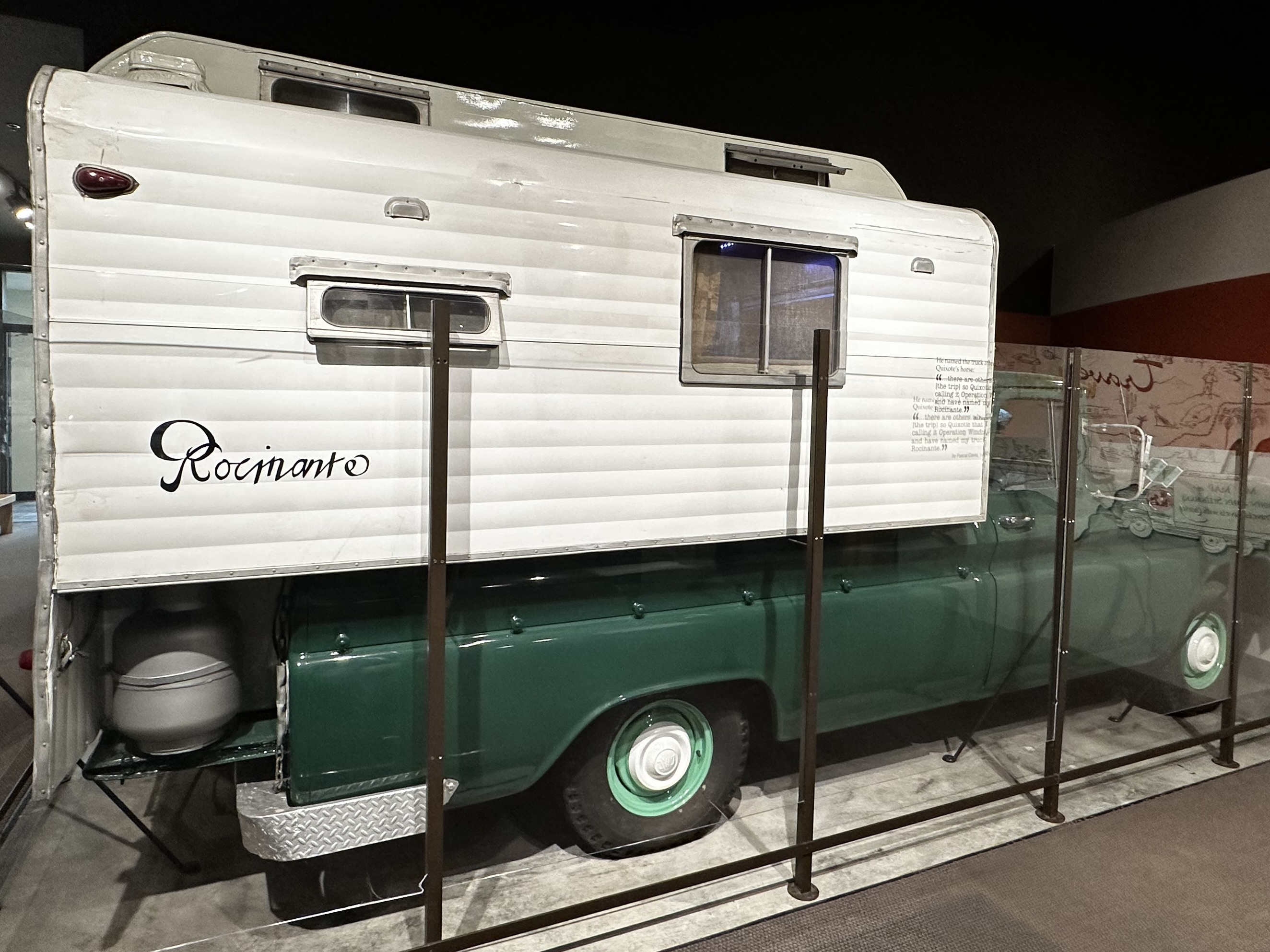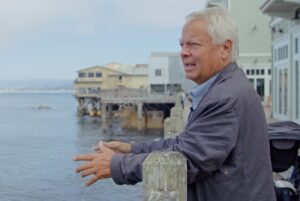After a harrowing drive down the California Coast, Clay arrives in John Steinbeck’s boyhood home of Salinas, California.

On Saturday, August 10, I gave a talk in the rotunda of the National Steinbeck Center in Salinas, California. The Steinbeck Center is the most significant interpretive center in the United States dedicated to the work of a single American author. It’s a beautiful facility in the heart of Salinas (today’s population is 160,000, and in Steinbeck’s youth, about 26,000). Steinbeck was born in Salinas, about three blocks from the Center, and though he died in New York City, he is buried in a cemetery in Salinas.

The Steinbeck Center has excellent exhibits covering the whole life and achievement of John Steinbeck, I’m glad to say, with a minimum of the kinds of electronic bells and whistles that now dominate interpretive centers around the country and which — in my experience — are “down for repair” or “currently unavailable” with considerable regularity. I’ve toured the Steinbeck Center exhibits a dozen times over the last 15 years. I’m never tired of them. And towards the end of the self-guided tour sits Rocinante, Steinbeck’s truck camper from the 1960 Travels with Charley tour of America.
I’m now at about the halfway mark of my 2024 Listening to America Steinbeck tour. I’ve reached the West Coast. Nothing to do now except turn back to the heart of America, which I will do later this afternoon after four marvelous days in California.

Before my talk, I stood for 10 or 15 minutes looking through the Plexiglas barrier into Steinbeck’s rig (as we road warriors like to put it!) And even though I have now driven 11,850 miles hauling a lovely 23-foot Airstream trailer (I’m having the time of my life), I was overwhelmed with emotion as I peered into the brown-paneled and somewhat cramped space of Steinbeck’s camper, which he commissioned in 1960 and likened to the cabin of a boat. Steinbeck’s Rocinante contained a small gas-fired refrigerator, a dining table that had to be taken down to make up the bed, a stove and oven, and a chemical toilet (yuck). The Center has put a milk bottle vase with flowers on the table — in homage to Steinbeck’s early encounter (September 1960) with a family of French Canadian potato pickers at the top of Maine (the “Canuck” incident), a typewriter (not his), and a kerosine lantern of the sort he bought in Stonington, Connecticut. The original drapes, purportedly fashioned by Steinbeck’s wife Elaine, are in the National Steinbeck Center archives. Still, the present ones were chosen to match Elaine’s aesthetics as closely as possible. As I stood there, I thought of the great American novelist, soon to win the coveted Nobel Prize in Literature, sitting at that dinette table on a brisk autumn evening somewhere in the vastness of America with his faithful (but capricious) poodle Charley draped around his feet. It’s a beautiful image — romantic, Steinbeck in harmony with the very Idea of America, with its vast distances and spaces, the 58-year-old writer “unplugged” in the middle of nowhere trying to decide who he still was, whether he still had what Jack Kerouac called “IT,” what America was now, and what held this “monster country,” as Steinbeck called it, together.

Detractors can prove that he did not always sleep in the rig, that his wife Elaine was with him more often than the 1961 book Travels with Charley acknowledges, and that his heart wasn’t entirely in his grail quest for the soul of America on the eve of John F. Kennedy’s election, on the brink of the tumultuous and revolutionary 1960s. Still, I can see him parked on a side road somewhere in America, musing about his extraordinary life and wondering what he still had left. No matter what the aggressive critics said and wrote, he was the author of The Grapes of Wrath, one of the five greatest novels in American history — and of Of Mice and Men, still widely staged in American theater 87 years after he wrote it, and East of Eden, a flawed but magnificent novel about the people and the land that shaped Steinbeck’s life and creativity. It is impossible to think of William Faulkner wandering America incognito in a truck camper, or Willa Cather, or Norman Mailer, or even Ernest Hemingway. There is a kind of nobility in the character of John Steinbeck. He wrote about the land and the people of the land, and during his most productive years, he was the tribune of the forgotten people who worked until they were bone “tar’d” (as Ma Joad puts it) to eke out a living against the oppressions of the privileged in “the land of opportunity.”

To look through that Plexiglass in the National Steinbeck Center is a privilege and a bittersweet joy. This amazing man, chock full of integrity, straining through his art to explain how life works for the less fortunate, suspending his immense wealth and privilege as the last decade of his life began to take to the road in search of the Soul of America.

I gave my talk mid-day Saturday and urged people to follow along at LTAmerica.org. Then I drove over to Monterey to see Doc’s lab, the statue group depicting the characters of Cannery Row, Lee Chung’s grocery store, the place where Ed Ricketts died, and more.
To get to Salinas in time for my talk, I had to plunge the length of California from Ashland, Oregon, to the Monterey Peninsula in just two days of hard driving. I’ve said if there were only one state, it would have to be Montana, but it might well have to be California, for that matter. Several years ago, funded by the California Humanities Council, I drove the whole state, from Susanville to Mount Shasta, from Temecula to Barstow, from San Bernardino to Bishop, from Lone Pine to Eureka, from Chico to Hearst Castle. There are many Californias, and though the state is now a blue republic, there are parts of it whose politics are hard red. I was in Fort Bragg the other evening, pumping $5.50 per gallon gas into my pickup when an older man approached me to praise my Airstream. I asked him about the state of the world. He said, “We cannot take four more years and survive.” I wanted to ask which four more years he had in mind, but I reckoned he meant four more years of Biden-Harris-Democrat rule. I asked innocently how the Biden world has damaged him or the U.S. He had no answer, mumbled something about oil drilling and Ukraine, but then he used the N-word to describe the current vice president of the United States.

I drove from Ashland to the Klamath River Valley, then California State Highway 96 to Eureka. From a time management point of view that was a serious mistake. CA 96 is about as windy a road as you will ever drive, but also wild, remote, and beautiful. Then I drove the U.S. 101 to Leggett and then the infamous Highway 1 to Fort Bragg. I had to grip the wheel with uninterrupted concentration to avoid plunging off the cliff into the Pacific Ocean. There are no guardrails, of course, and every eight or nine miles, bridge construction with that extremely annoying stop light to facilitate traffic over the one open lane. I slept under baby redwoods at an RV park near Fort Bragg. They were only 100 years old but towered over my Airstream to 80 or 90 feet. When you think of California, you envision the great freeway system, but I have (perhaps recklessly) spent my time on the roads less traveled. On CA 20 from Fort Bragg back to 101 and Ukiah, I threw a hubcap and watched it roll like a hula hoop down the road. I lost time, too, on the Avenue of the Giants in the heart of California’s redwood forest because I stopped a dozen times to venture into the forest in hushed religious awe. Then, I had to skirt San Francisco during the Friday rush hour. You only have to hear those words to shudder.
In short, by the time I got to Salinas, I was, well, ready to get off the road for a bit — and a complete emotional wreck. But happy.
I rest my weary spirit tonight at an RV park that announces itself as an oasis in the almond groves. I love almonds more than any other nut (except pistachios, which are so fabulous and exotic that they don’t count). Still, my joy in them has been chastened lately because of the now permanent water crisis in California. It takes two gallons of water to grow a single almond. There are thousands of acres of the trees that produce them in every direction.

I can hear the incessant traffic of restless America on I-5, half a mile from my RV site #40. The dusk traffic (everyone heading somewhere) reminds me not of Steinbeck but my other road hero, Jack Kerouac. My favorite sentence in On the Road is, “Whither goest thou, America, in thy shiny car in the night?” The half-moon looms over the southwestern sky — meteor showers to follow. A fifth-wheel behemoth just rolled into site #53, and the older couple is squabbling about leveling the rig in the dark. Their dog is looking eagerly at its masters without success. The almond groves are now enveloped by an almond sunset afterglow. The temperature has dropped to just 90 bone-dry degrees. I am not hot, but I am very tired. I will pour myself a glass of pinot noir and slip between the sheets with a good book.
The lonely I-5 gas station across the way, with a Subway sandwich shop inside, proclaims diesel at $4.47 per gallon. It’s only 8:34 p.m., but everyone in the RV park is asleep or watching Wheel of Fortune. I hear crickets in the ditches. All is peace.
I am in love with America.
And so goodnight from somewhere in the vastness of this remarkable troubled land.
Editor’s Note: Over the next few months, Clay is shadowing Steinbeck’s 10,000-mile trek around the USA (and making a few detours of his own). Clay’s expedition is a central part of LTA’s big initiative to explore the country and take the pulse of America as it approaches its 250th birthday. Be sure to follow Clay’s adventures here and on Facebook — and subscribe to our newsletter.
